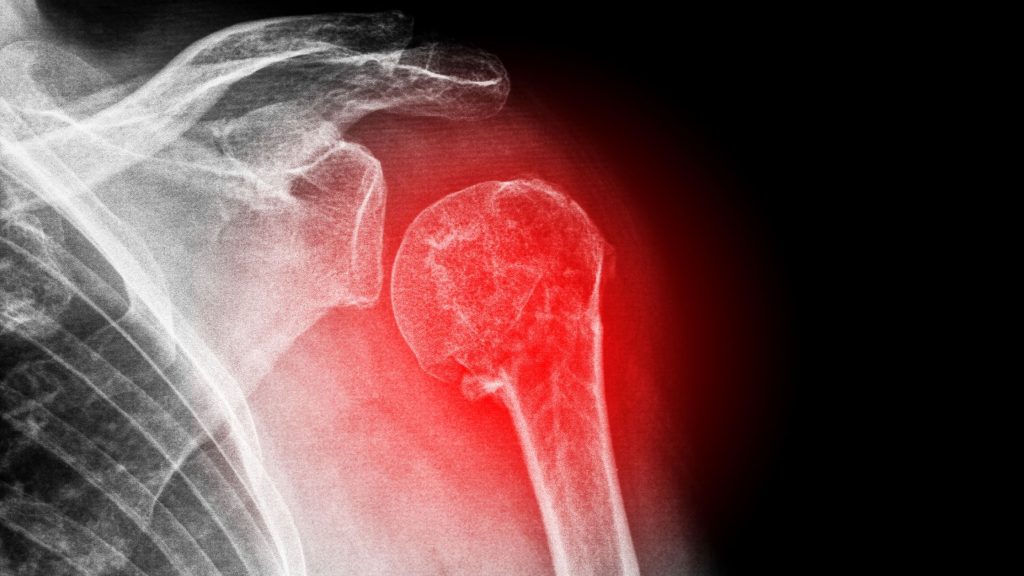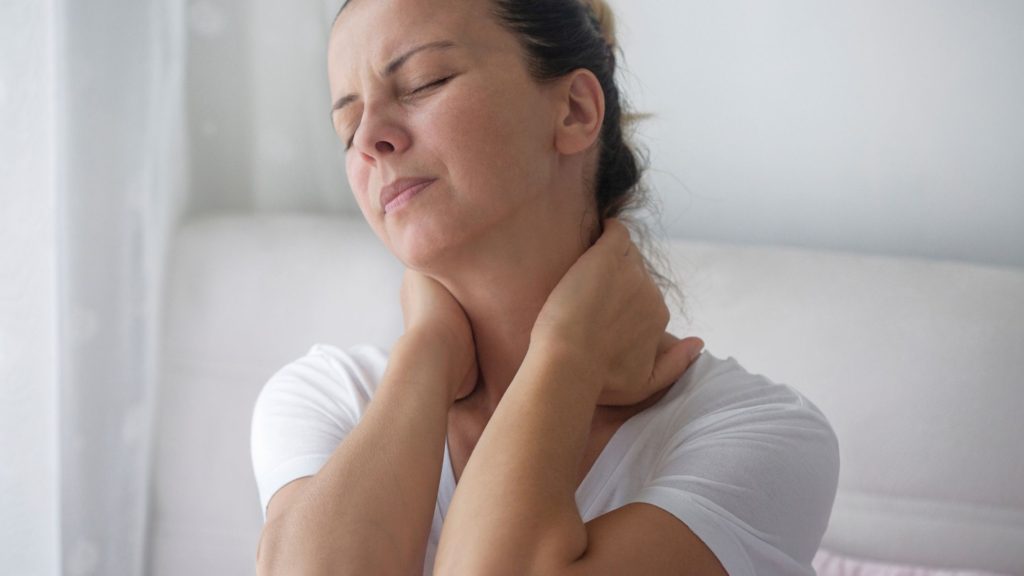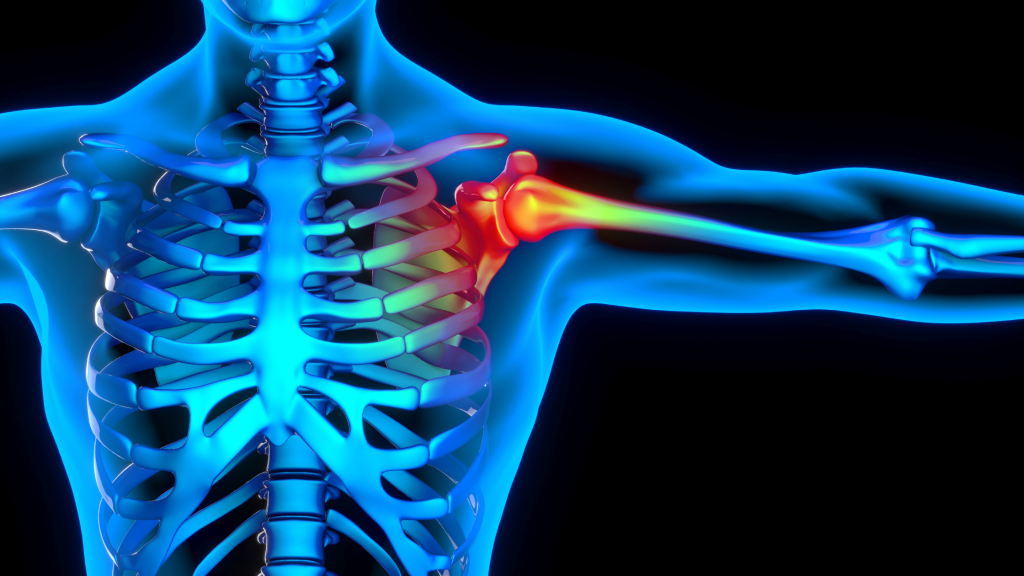Last updated on May 27th, 2024 at 05:39 pm

There are many causes of pain on the tip of the shoulder. It could be subacromial bursitis, peri-arthritis shoulder, biceps tendinitis, or many more, which we are going to discuss.
However, they all differ in the nature of pain and shoulder movement restriction mechanism; their causes are different, and their histories are different.
In this article, I will break down all the possible causes of tip shoulder pain and provide the signs and symptoms to help find yours. So, let us get started.
6 causes of pain on the tip of the shoulder
The tip of shoulder pain may or may not be associated with painful restriction of shoulder joint motion. But they most often coexist, and the good thing is that most of them can be managed with simple home exercises.
We will learn the six most common causes of tip-of-the-shoulder pain. Let us start with subacromial bursitis.
1) Subacromial bursitis
If you have throbbing pain on the tips of the shoulders that increases with shoulder movement in any direction, then chances are it is due to subacromial bursitis.
Swelling and redness around the shoulder with pain at the tip of the shoulder are signs of a painful condition known as subacromial bursitis.
It is often seen in individuals who participate in repetitive overhead activities, such as athletes, factory workers, and manual labourers. Older individuals are more prone to experiencing subacromial bursitis, likely due to years of wear leading to an increase in subacromial impingement.
If the problem is detected early, it can be easily managed with physiotherapy and exercise. Read my “Subacromial bursitis: Causes, Treatment & Exercises” for more information.
2) Adhesive capsulitis
Adhesive capsulitis is also known by other names, such as frozen shoulder and peri-arthritis shoulder. Adhesive capsulitis is a very painful shoulder condition where the shoulder becomes stiff.
You will have difficulty and pain raising your shoulder, combing your hair, undoing your clothes, and reaching your back pocket.
One of the most important signs is nocturnal shoulder pain, i.e. disturbed sleep due to night shoulder pain. Although it is commonly seen in females and diabetics, it can affect anyone. The common cause of frozen shoulder is:
- Pain- Because of pain, the shoulder remains immobilised, which leads to adhesion formation in the shoulder joint’s capsule.
- Immobilisation– In some cases, the condition is initiated by a period of immobilization, such as prolonged use of a shoulder sling after Colle’s fracture.
- Posture– Wrong posture like kyphotic, head forward, rounded shoulder.
- Occur more in females, particularly postmenopausal women.
- Diabetics are found to be more prone to it.
Physiotherapy and regular exercises are very important for treating the frozen shoulder. I have already covered these topics in my previous post, which you may visit for information.
- 5 frozen shoulder exercises for quick relief.
- 4 Easy Shoulder Wand Exercises for Painful, Stiff Shoulder
3) Biceps tendinitis
Biceps tendinopathy is a relatively common ailment that typically presents as pain, tenderness, and weakness in the tendon of the long head of the biceps brachii. The exact point is the shoulder joint line’s anterior (front) part.
Often, the pain may be diffuse or vague, especially when another condition, such as rotator cuff disease, subacromial impingement, or shoulder instability, is present. Sensations of instability, popping, and grinding should be noted and qualified to location and arm position.
4) Rotator cuff tendinitis/tear
When a patient partially tears their rotator cuff (RC), they are expected to present with reduced shoulder function with shoulder weakness, pain, and stiffness). They may also have pain at rest, night pain, or a painful arc.
The signs of impingement may include painful overhead reaching, an inflamed subdeltoid bursa, or positive special tests to provoke symptoms.
Patients can also present with pain radiating to the lateral mid‐arm or tip of the shoulder, pain while lying on the shoulder or sleeping with the arms overhead, and pain that occurs when reaching above the head.
Learn more about rotator cuff tear exercises here: 12 Easy Rotator Cuff tear Exercises for Shoulder Pain Relief
5) Impingement syndrome
Shoulder impingement is a clinical syndrome in which soft tissues become painfully entrapped in the area of the shoulder joint. Patients present with pain when elevating the arm or lying on the affected side.
Patients affected by shoulder impingement syndrome are generally over age 40 and suffer from persistent pain without any known preceding trauma. The cause may be excessive stress on the shoulder joint or a trivial injury.
Patients report pain when elevating the arm between 70 ° and 120 ° (the “painful arc”) when forced to move above the head and when lying on the affected side.
6) Acromioclavicular joint osteoarthritis
This is the common cause of the tip of shoulder pain in elderly people. Osteoarthritis of the acromioclavicular joint is a common source of shoulder pain often neglected by clinicians.
Injuries are a common precipitating cause, occurring through direct impact on the joint or a fall on an outstretched arm. Arthritis is the leading cause of pain, and it develops due to constant stress on the joint, often in people who perform repeated overhead lifting activities.
Unfortunately, physical therapy has little to offer, as therapeutic exercise and range of motion play only a minor role.
Conclusion
In conclusion, pain on the tip of the shoulder can be caused by various conditions such as subacromial bursitis, adhesive capsulitis, biceps tendinitis, rotator cuff tendinitis/tear, impingement syndrome, and acromioclavicular joint osteoarthritis. Proper diagnosis and treatment, which may include physiotherapy and exercises, are essential for managing these conditions effectively.
If you are experiencing shoulder pain, it is important to seek medical advice to determine the underlying cause and receive appropriate care.
The author is a physiotherapist who has been practising for the last 17 years. He holds a Bachelor's in Physiotherapy (BPT) from SVNIRTAR (Swami Vivekananda National Institute of Rehabilitation and Research), one of the prestigious physiotherapy schools in India.
Whatever he learns dealing with his patient, he shares it with the world through blogs and e-books. He also owns a YouTube channel, "Sunit Physiotherapist" with over 8 lakh active subscribers. Here, he shares everything he gets to learn serving the patient.






Pingback: How do I Stop My Shoulder from Hurting when I Sleep? : Physiosunit
After football injury my shoulder pain got so worse that it had no mobility. I found out the shoulder treatment program from painsumo which helped me alot.
After football injury my shoulder pain got so worse that it had no mobility. I found out the shoulder treatment program from painsumo which helped me alot.
I want to testify of how i got cured from Herpes with the use of herbs. I got diagnosed of Herpes in 2018 I have visited several hospitals but all to no avail, my world was gradually coming to an end but i keep believing there is cure. I saw a post in a health forum from miss cherlyn solie on how she was cured from herpes with the use of Dr ekpen herbs and she also wrote Dr ekpen cure all kind of deadly diseases including Herpes, HIV, ALS, HPV, HSV1&2, MND, Epilepsy, Leukemia, Asthma, Cancer, Diabetes. At first i doubted if it was real but decided to give it a try and i contacted this herbal Doctor on email she provided on the comment and explain my problem to him and he told me that he is going to prepare a herbal medicine for me which he did and he sent it to me through UPS service, when i received this herbal medicine, he gave me instructions on how to use it, after taken the medicine as instructed, i went for check up and the result shows negative and i was cured from herpes in a week, I am now free from Herpes. You can contact Dr ekpen on his email: DR.ekpen001@gmail.com or you can call and Whatsapp him on +2348169824538
Informative post.
I periodically have pain in this area (not to often though), possibly because I have an injury in this area a while back. Hopefully it will not get worth with age.
Thank u so much
I don’t have shoulder blade pain, but my shoulders are noticeably uneven. Is there any exercises you would recommend for uneven shoulders? If someone could get back to me I’d really appreciate it !
valuble
hello:)